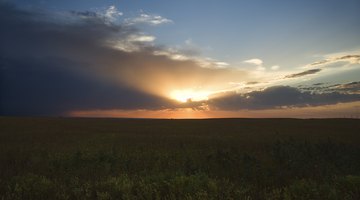What Is the Difference Between a Calcified & a Leached Soil Profile?
Factors like climate, type of parent material and type of vegetation can all play important roles in shaping a soil's properties and the resources it can afford plants that grow there. Broadly speaking, there are three major categories of soil forming processes.

In two of these, leaching plays a significant role in vertical distribution of nutrients; in the third, leaching is virtually absent and plays little or no role.
Calcified Soils
In warm, dry grasslands, soil bacteria and fungi rapidly convert decaying organic matter into humus, so the upper layers of the soil become rich. Burrowing animals mix this organic matter deeper into the soil. The grasses uptake plenty of calcium and draw it up from lower layers of the soil; when they die, they return it to the upper layers, so these soils tend to be slightly alkaline and feature large quantities of calcium salts. For this reason, they are called calcified soils. Calcification can also take place in desert regions; only here, the process is somewhat different -- water rising through capillary action leaves deposits of calcium carbonate, and little or no organic matter is present.
Soil Leaching
Leaching is what happens when water removes soluble nutrients from a soil over time. Calcified soils ordinarily exhibit little leaching, although improper land management can lead to substantial leaching and thus the loss of soil fertility. Deserts with calcified soil profiles can be fertile if highly irrigated, although the amount of water required is a problem. Two other soil formation processes, however, lead to profiles where leaching plays a substantial role in nutrient distribution. These processes are laterization and podzolization.
Laterization
A laterite soil profile often forms in hot, moisture-laden tropical regions, where chemical processes rapidly break down rock to furnish more parent material for the soil. Decomposition occurs very quickly, but the nutrients recycled into the soil are rapidly pulled back out by other vegetation. Remaining nutrients tend to be leached out of the upper layers by the water, so despite the lush nature of the vegetation they support, these soils are actually nutrient-poor. Almost all the nutrients are actually contained by the vegetation itself, and when this is removed the soil is unsuitable for agriculture.
Podzolization
The cooler forests of temperate regions also feature heavy leaching in the soil. The decomposing litter on the surface is rich in organic acids, which assist in leaching the mineral nutrients from the topmost layers of the soil. Fine clay particles also tend to move downward, leaving behind a coarse, nutrient-poor upper layer. The subsoil, meanwhile, ends up with plentiful clay and thus becomes more impermeable over time. This whole situation works well for trees and shrubs with roots that reach beneath the uppermost layer; but for grasses, it's an undesirable state of affairs. Soils in deciduous forests tend to be less acidic than those in pine forests.
The Drip Cap
- Factors like climate, type of parent material and type of vegetation can all play important roles in shaping a soil's properties and the resources it can afford plants that grow there.
- The grasses uptake plenty of calcium and draw it up from lower layers of the soil; when they die, they return it to the upper layers, so these soils tend to be slightly alkaline and feature large quantities of calcium salts.
- For this reason, they are called calcified soils.
- The decomposing litter on the surface is rich in organic acids, which assist in leaching the mineral nutrients from the topmost layers of the soil.
- This whole situation works well for trees and shrubs with roots that reach beneath the uppermost layer; but for grasses, it's an undesirable state of affairs.
References
Writer Bio
Based in San Diego, John Brennan has been writing about science and the environment since 2006. His articles have appeared in "Plenty," "San Diego Reader," "Santa Barbara Independent" and "East Bay Monthly." Brennan holds a Bachelor of Science in biology from the University of California, San Diego.
Photo Credits
- Thinkstock/Comstock/Getty Images
- Thinkstock/Comstock/Getty Images
More Articles



